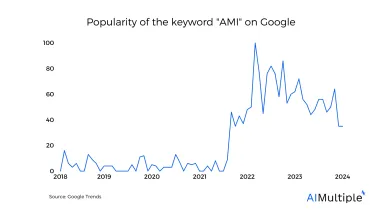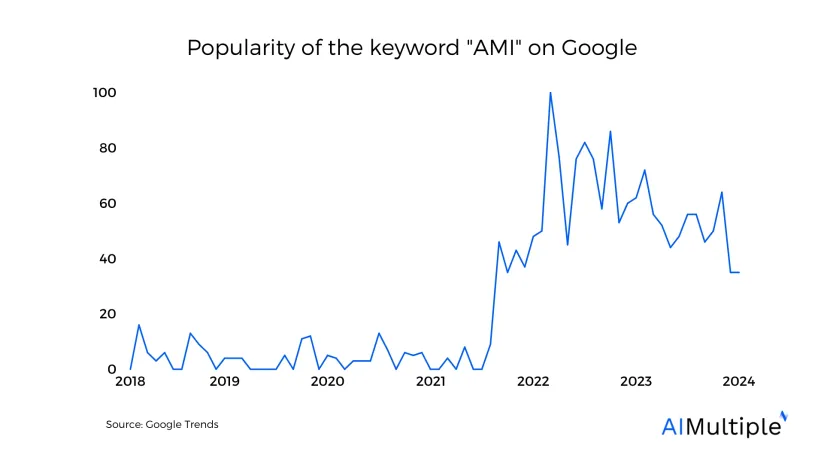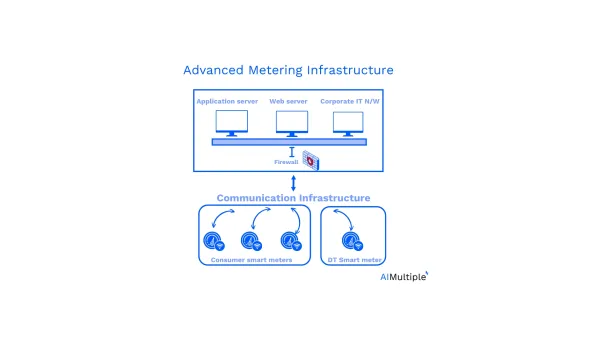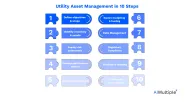Advanced Metering Infrastructure: 12 Use cases & 10+ Solutions


Advanced metering infrastructure (AMI) is an integrated system, including smart technology solutions with specific advanced capabilities. AMI captures interval data points to monitor and manage factors like voltage stability and frequency flections, maintaining power quality. This is why the interest in AMI has been at rise since 2022 (See Cover image).
However, AMI is not an easy topic to cover since it encompass various technologies and multiple vendors. Therefore, we aim to cover AMI inside out, helping utility leaders to learn AMI better and identify top solutions for their business.
Advanced metering infrastructure solutions
The AMI market covers a diverse range of solution providers, varying in size and offerings. The table presented below categorizes large-scale advanced metering infrastructure solutions according to their respective employee numbers. The review score column provides insights into the performance of these tools, displaying both the number of reviews and the average score on Gartner.
| Company | Headquarters | Foundation year | Number of employees | B2B review score |
|---|---|---|---|---|
| IBM Maximo for Utilities | Armonk, USA | 1911 | 309,079 | 4.3/5.0 based on 266 reviews |
| General Electric | Boston, USA | 1892 | 218.847 | 3.9/5.0 based on 12 reviews |
| Siemens | Munich, Germany | 1847 | 214,501 | 4.5/5.0 based on 100 reviews |
| Cisco | San Jose, USA | 1984 | 99,720 | NA |
| ABB | Zürich, Switzerland | 1988 | 98,636 | 4.0/5.0 based on 1 reviews |
| Schneider Electric SE | Rueil-Malmaison, France | 1836 | 81.143 | 4.3/5.0 based on 46 reviews |
| Eaton The Brightlayer Utilities suite | Dublin, Ireland | 1911 | 46,233 | 5.0/5.0 based on 1 reviews |
| Sensus by Xylem | Washington, USA | 2011 | 14.382 | 4.0/5.0 based on 1 reviews |
| Itron | Liberty Lake, USA | 1977 | 5,497 | 4.6/5.0 based on 52 reviews |
| Landis+Gyr | Switzerland | 1986 | 4,777 | 4.5/5.0 based on 6 reviews |
| Kamstrup | Skanderborg, Denmark | 1946 | 1,501 | NA |
| Aclara Technologies Llc. | USA | 1977 | 968 | NA |
| Trilliant Inc. | San Fransisco | 1995 | 378 | NA |
5 Complementary tools to optimize AMI operations
The deployment of Advanced Metering Infrastructure (AMI) extends beyond the hardware and communication elements, encompassing strategic utilization of diverse tools for automation, management, and orchestration. In tandem with Workload Automation (WLA) tools, several advanced solutions synergise with AMI, elevating overall operational efficiency and performance.
1.) Workload automation and job scheduling tools: Workload automation (WLA) tools automate and schedule tasks within AMI. WLA can streamline workflows, automate data collection, transmission, and processing for precise and timely readings. Some WLA tools can seamlessly integrate into ERP systems, like SAP utility solutions and orchestrate meter-to-cash process, which is why they can be included in meter-to-cash solutions
Explore other WLA tools through our comprehensive and data-driven vendor lists.
2.) Energy management systems (EMS): These systems are focused on optimizing energy consumption and distribution. EMS facilitates usage patterns analysis, demand response strategies implementation, and overall smart grid performance improvement.
3.) Cybersecurity solutions: These tools can safeguard sensitive data in the AMI ecosystem, ensuring protection against unauthorized access, guaranteeing the integrity and confidentiality of transmitted and processed data.
Explore our comprehensive and updated vendor lists of various cybersecurity tools, such as application security and DAST tools.
4.) Advanced analytics platforms: These tools are can offer profound insights into meter data. They leverage machine learning and data analytics for pattern identification, demand forecasting, and data-driven decision-making to enhance operational efficiency.
5.) IoT Devices and sensors: IoT tools and sensors can enhance connectivity and data gathering capabilities. They enable a more granular understanding of energy consumption patterns and supports data-driven decision-making in AMI operations.
What is advanced metering infrastructure?
Advanced Metering Infrastructure (AMI) is a bidirectional communication system employed to collect detailed metering data within utility service sectors. This automated system facilitates real-time and on-demand communication with metering endpoints.
AMI can collect time-differentiated energy usage, preferably through a two-way fixed network. It provides usage information to electricity customers, utilities, and other stakeholders daily or more frequently, supporting various functionalities such as outage management and connect/disconnect. AMI extends beyond basic metering, requiring ample bandwidth for activities like demand response/load management and Distribution automation.
Type of data advanced metering infrastructure solutions transfer
AMI systems handle diverse energy data, essential for understanding usage and grid dynamics. Types include kWh usage, peak kW demand, load profile, voltage details, outage logs, tamper alerts, and more. Electric metering endpoints contribute to data collection and analysis, offering insights into consumption, grid performance, and customer behavior.
High-end AMI systems go further, enabling real-time access to this information. This empowers utilities with enhanced operational insights, facilitating agile decision-making and proactive grid management based on a granular understanding of data types.

AMI system main components
AMI integrates components like:
- Smart Meters: Smart meters are digital devices for gas, electric, and water meters. They record energy consumption at intervals of an hour or less, and transmit data back to the utility company at least once daily.
- Communication networks: Communication networks serve as the backbone for two-way communication and can be either wireless or wired based on the system topology. These networks facilitate the transmission of data between smart meters and the Advanced Metering Infrastructure (AMI) head-end system, utilizing various mediums such as radio frequency signals, cellular networks, broadband connections, or power line communication.
- Transmission mediums: Utilizing various mediums such as radio frequency signals, cellular networks, broadband connections, or power line communication, transmission mediums facilitate the transfer of usage information to utility companies.
- Remote management: Remote management eliminates the need for manual meter readings, enabling faster response times during power outages. Additionally, it allows for remote commands such as disconnect/reconnect and firmware updates.
- Data management system: The Data Management System serves as a central repository for collecting, storing, processing, and analyzing meter data. This system converts raw data from smart meters into actionable insights, empowering utilities with information for operational improvements.
Understanding the AMI Workflow
- Data Collection and transmission: Smart meters, installed at customers’ locations, automatically record energy usage. Then, they send consumption data regularly back to the utility company.
- Data reception and management: The AMI head-end system acts as a central hub for data from all smart meters. This system verifies and processes the data before forwarding it to the Meter Data Management System (MDMS).
- Data processing and analysis (MDMS): MDMS transforms raw data into meaningful information. Utility companies use this information for decisions like load forecasting and managing transformer load during outages.
- Customer interface: Utility companies share data insights with customers. Customers can access detailed energy usage information through portals and displays, encouraging energy-saving habits.
- Outage notification and management: AMI systems have outage management features. Smart meters receive signals before power loss, aiding quick issue identification and resolution.
12 AMI Use Cases
- Verify power outages and service restoration: AMI systems swiftly identify and report power outages, reducing downtime and improving service reliability, enabling utilities to pinpoint outage locations for quicker repairs.
- Remote service disconnects and reconnects: AMI solutions can provide utilities with the ability to remotely connect or disconnect services. This way, they eliminate the need for physical visits, ensuring faster and more efficient service adjustments.
- Automated net metering: AMI allows for seamless automated net metering, streamlining the process of crediting customers for excess energy they feed back into the smart grid.
- Transmit demand response and load management messages: AMI enhances demand response programs by allowing real-time monitoring of energy usage. Therefore, it enables utilities to send signals to consumers during peak demand periods, promoting load balancing and preventing outages.
- Interrogate and control distribution automation equipment: AMI systems facilitate the interrogation and control of distribution automation equipment, optimizing grid operations.
- Demand response programs: AMI enables real-time monitoring of energy usage, which allows utilities to send signals prompting consumers to reduce consumption during peak demand, aiding load balancing. This help enhance demand response initiatives.
- Outage detection and management: AMI automatically detects and reports power outages, reducing downtime and improving service reliability. This way, it helps utilities quickly locate and address outage issues.
- Remote Connect/Disconnect: AMI allows utilities to remotely manage service connections and disconnections, speeding up the process without requiring physical visits.
- Theft detection: As AMI can monitor energy usage patterns to detect irregularities that may indicate theft. AMI identifies instances of low or no consumption despite premises being occupied.
- Enhanced customer service: Utilities can benefit from AMI data to offer personalized energy-saving tips and recommendations to customers, empowering customers to manage their energy consumption effectively.
- For example, Horizon Power replaced its old old prepayment meters with an AMI solution. The solution offers smart meters, enabling customers to choose prepayment or credit metering and to switch between the two solutions as they desire. This new solution was selected by more than 90% of customers where the service is available. The program also helped customers connected by managing customer debt and tracking cash flow, improving customer service. 1
- Enabling Distributed Generation: AMI supports utilities in effectively managing distributed, renewable energy resources like solar panels by providing real-time data on energy production and help integrating into the power grid.
Difference between AMI and AMR
Automatic Meter Reading (AMR) and Advanced Metering Infrastructure (AMI) are technologies designed to streamline meter reading processes, but they differ in scope and capabilities.
| Automatic Meter Reading (AMR) | Advanced Metering Infrastructure (AMI) | |
|---|---|---|
| Technology | Relies on radio-based meter modules (ERT modules) installed on water
meters.
| Comprehensive system integrating smart meters, communication networks, and data management
tools.
|
| Reading Process | Meter readings collected by a handheld or vehicle-based radio device
or a fixed network system.
| Enables two-way communication, allowing real-time data collection and remote monitoring
without manual intervention.
|
| Application | Reduces the need for manual readings but still involves meter
readers collecting data in the field.
| Goes beyond meter reading, offering enhanced features like outage detection,
demand response, and distribution automation.
|
| Advantages | Eliminates the necessity for entering customers' homes, improving safety and
efficiency.
| Significantly reduces labor needs, enhances system reliability, and provides operational
efficiencies. Enables utilities to focus on broader aspects of service improvement.
|
Key Differences:
- Data Collection Process: AMR relies on field-based data collection, whereas AMI allows for real-time, remote monitoring without the need for manual intervention.
- Scope of Functionality: AMR primarily focuses on automating meter reading processes, while AMI integrates smart meters and advanced communication networks for a broader range of utility management functions.
- Operational Efficiency: AMI offers higher operational efficiency with features such as outage detection and demand response, leading to a reduced need for labor compared to AMR.
Further reading
Read more on different technologies used in utility automation and management:
- Top 5 Digital Technologies Transforming The Energy Sector
- Compare 10 SAP Utility Solutions based on +3000 reviews
- 10 Tips to Master Utility Asset Management
- SAP Meter to Cash Process: 10 Technologies to automate it
If you have more questions on AMI and other solutions to automate or orchestrate utilities, do not hesitate contacting us:
External sources
- 1. “Case Study: Horizon Power.” Itron. 2021. Accessed at January 25, 2024.



Comments
Your email address will not be published. All fields are required.